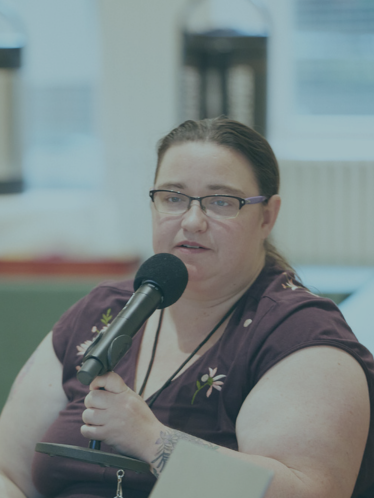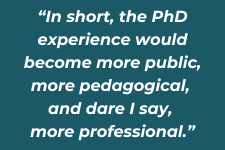What Can Undergraduate Innovation Teach Graduate Programs?
Stacy Hartman is the former director of the PublicsLab at the CUNY Graduate Center, where she supported public scholarship and efforts to transform doctoral education. Read more about her work at stacyhartman.com.
For many years now, the prevailing assumption about the purpose of doctoral education has been that it exists to replenish the research professoriate. It, therefore, follows, commonsensically, that the PhD should be reverse-engineered from the tenure process at R1. But as humanists, part of what we are trained to do is subject “prevailing assumptions” and “common sense” to critique and inquiry. I therefore have found myself asking recently, “What if we took something else entirely as the starting point for designing doctoral programs?”

Since I completed my own doctorate in 2015, there have been slow but significant shifts in doctoral education. I have seen many faculty members change the way they advise their graduate students, toward a much greater range of careers. The membership numbers of the Graduate Career Consortium have more than doubled since 2014, as more universities have hired career advising staff to work primarily with graduate students. I have also seen a shift of attention toward public scholarship, including the rise of new graduate degrees and certificates. Many departments and programs are more concerned about equity, though inclusion will always be a thorny concept in a system based on prestige.
At the same time, undergraduate humanities programs have made even more dramatic changes in response to falling enrollments. The University of Washington’s Humanities First initiative is a first-year program that combines classroom learning with activities and excursions. There has been a correlating 227% jump in declared humanities majors at UW since 2017; previously, their numbers had been in steep decline. At Purdue University, the Cornerstone Integrated Liberal Arts is a fifteen-credit general education sequence that leads to a certificate. A two-semester sequence in students’ first year is focused on “transformative texts”; beyond the first year, students choose from a range of themed, three-course sequences designed to complement their chosen areas of study. Originally conceived in response to falling enrollments, Cornerstone has revived the liberal arts at STEM-centered Purdue –– and is now serving as a model for other universities and colleges, with the support of the NEH and the Teagle Foundation.
These changes in doctoral education and undergraduate education are linked to similar forces –– chief among them, challenging job markets and the increased cost of education. Doctoral education and undergraduate education feed into one another: doctoral students teach undergraduates as part of their training; undergraduates go on to become graduate students themselves; doctoral students are hired by a range of institutions with the expectation that they will contribute to efforts to reverse enrollment declines.
Despite all these points of connection, it often feels like the conversations about doctoral and undergraduate education are happening in separate rooms. But what if we tied them together? What if we reverse-engineered doctoral education from the innovative undergraduate education we would like to see?

Were this to happen, I suspect that we would see major shifts in all areas of doctoral training. First and foremost, programs would need to take their pedagogical training much more seriously, with a semester-long course on teaching in the discipline and perhaps even an advanced course for those who want it. Graduate students would also be brought into departmental conversations from which they are often excluded, such as admissions, enrollments, and new program development. They would see firsthand how departmental decisions are made and what it takes to “stand up” a new program. Students would be encouraged to think about the audiences they’d like to reach and the impact they would like to make with their research. These research experiences would feed back into their teaching, mentoring, and service work. In short, the PhD experience would become more public, more pedagogical, and dare I say, more professional.
I am aware what the pushback to this argument will be, because I have heard it many times before: Some students will go on to tenure track jobs at R1 institutions, and we must serve them, too. A profile that is “too weird” will put students at a disadvantage on the academic job market. Furthermore, all these additional experiences and requirements will dilute the core essence of the PhD, which is research.
I agree that original research is and should remain at the heart of the PhD. However, our understanding of what that looks like should be expanded, and as our understanding expands and evolves, so should tenure requirements –– to better reward public scholarship, innovative teaching and program development, and outstanding mentorship. At the moment, these systems are often at odds, and that leads to tension, anxiety, disappointment, and ultimately attrition by promising young scholars at every stage.
To bridge transformative efforts in graduate and undergraduate education, faculty members at different institutions must talk to one another across both disciplines and institutions. If you are a faculty member at a PhD-granting institution, are your grad students aware of the innovations happening at your own institution? Then, take a look at humanities departments at the 2- and 4-year colleges in your region. What are they doing for their students? Are your graduate students prepared to teach in those departments? As a second step, faculty from those neighboring institutions could be invited to be part of a conversation about doctoral training. They undoubtedly have thoughts on how their own training did or did not prepare them for their current positions, and they may have recently participated in hiring for junior roles.
This is a very different way of thinking about doctoral education. But we are all aware of what is at stake: the ability of the humanities to survive and thrive in a STEM-driven world. Undergraduate programs are increasingly adapting. Doctoral programs must, as well.

